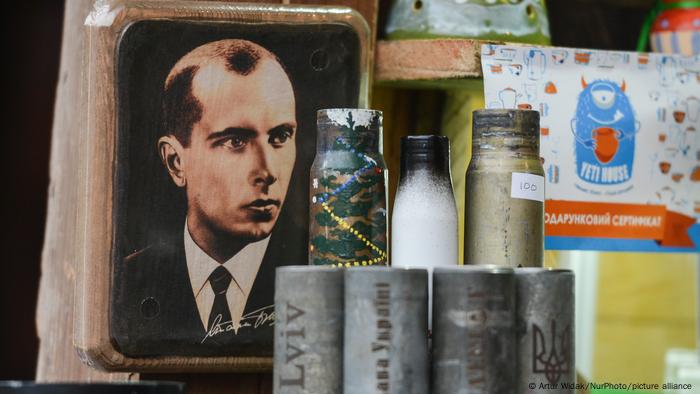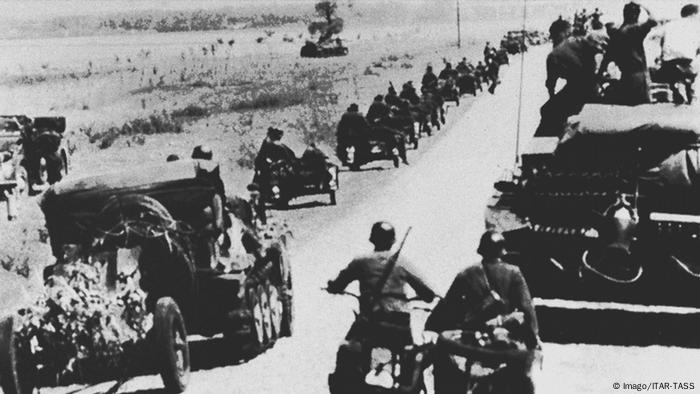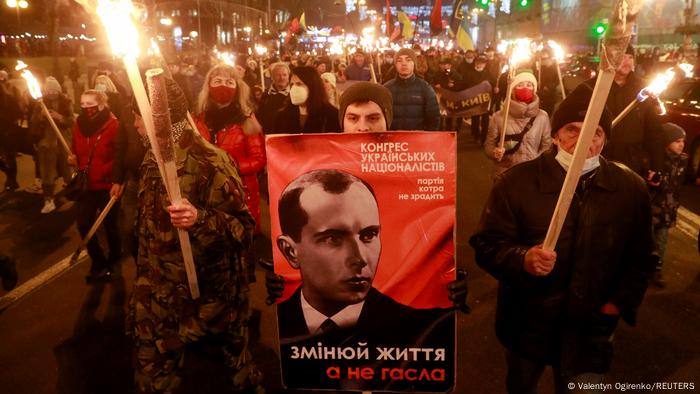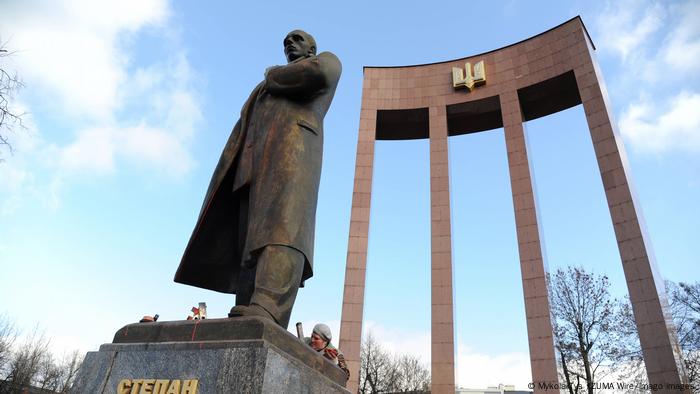The Mariupol fighters honor him, Russian soldiers hunt his supporters. Stepan Bandera, the best-known Ukrainian nationalist, is still seen by some as a symbol of the Ukrainian resistance. Who was he?

Bandera -Picture on a market in Lviv (archive)
“Our father is Bandera, Ukraine is the mother. We will fight for Ukraine!” A young woman in camouflage uniform and with a machine gun sings this song in a video shared on social networks by the Ukrainian defenders of Mariupol in early May. The video was apparently recorded in a bunker of the Azov steelworks, the last place of Ukrainian resistance against Russian troops in the city. There were also fighters from the “Azov” regiment, which was created by radical nationalists and later subordinated to the Ukrainian Ministry of Internal Affairs.

Azov fighters in Mariupol, 2014
Stepan Bandera, who was killed more than 60 years ago by Soviet secret services in West Germany, is probably the best-known Ukrainian nationalist. His name became a symbol long before the open war that Russia has been waging against Ukraine since February 24.
Bandera is a hero and role model for part of Ukrainian society. Russian propaganda portrays him as an enemy whose followers have been fighting for decades. For Russian military officials, his name is a kind of clue or marker to go on downright hunts for Ukrainians in the occupied territories. Ukrainian media are full of eyewitness accounts of how the Russians were looking for Bandera supporters among Ukrainian POWs and civilians. Those classified as such face torture or death. When Russia's President Vladimir Putin justified the war against Ukraine in his speech on Red Square on May 9, he spoke of an unavoidable confrontation with “neo-Nazis, Banderists”.
Bandera – Life and death of a radical fighter
Bandera's life is closely connected with western Ukraine, which was then part of Poland and Austria-Hungary. He was born in 1909 as the son of a priest in the village of Staryj Hryniv, now in the Ivano-Frankivsk region. Bandera studied in Lviv (Lemberg) and joined the Organization of Ukrainian Nationalists (OUN), which fought underground for independence. In the 1930s, Bandera was convicted as a co-organizer of political murders in Poland and was only released after the start of World War II. Soon thereafter there was a split in the OUN, with Bandera placing himself at the head of the more radical wing (OUN-B). While Nazi Germany was preparing to invade the Soviet Union, Bandera comrades-in-arms joined the German leadership with two Ukrainian battalions: “Nachtigall” and “Roland”.

Nazi troops invading the USSR, June 1941
A key event in Bandera's life took place on June 30, 1941. His comrades-in-arms proclaimed an independent Ukrainian state in Nazi-occupied Lviv. Bandera was in occupied Poland at the time, the Germans did not allow him to travel to Ukraine. Hitler rejected the idea of Ukrainian independence, Bandera was arrested and spent most of the war, until 1944, in Sachsenhausen concentration camp. His OUN-B continued to fight for independence in Ukraine – with the help of its military arm, the Ukrainian Insurgent Army (UPA). OUN-B fighters were persecuted and killed by the Nazis and the Soviets. Bandera lived in Munich after the war, where he was killed with cyanide by a KGB agent in 1959.
Bandera cult in modern-day Ukraine
After the assassination, Bandera was worshiped by Ukrainian émigrés in the West. The cult surrounding him arose after the collapse of the Soviet Union in western Ukraine, where museums, monuments and streets commemorate him. However, citizens in other parts of Ukraine, especially in the east, stuck to the Soviet historiography, which saw him exclusively as a Nazi collaborator. Her attitude towards Bandera was negative. Under the pro-Western Ukrainian politician Viktor Yushchenko, who became president in 2005, Bandera was awarded the title of “Hero of Ukraine”. His successor, the pro-Russian Ukrainian President Viktor Yanukovych, had the title revoked.

Bandera supporters in Kyiv , January 2021
Bandera's supporters march through the capital in a torchlight procession every year on his birthday. In 2016, the street name Moscow Prospekt in Kyiv was changed to Bandera Prospekt. The attitude towards the historical figure became more and more positive, but before the war society was divided. A survey by the “Democratic Initiative” foundation in April 2021 found that a third of Ukrainians (32 percent) rated Bandera's work as positive, just as many – negative.
What Ukraine Bandera wanted
< p>Andreas Umland, an expert at the Stockholm Center for East European Studies, describes the Bandera cult as “an expression of selective memory and historical politics”. It is recalled that Bandera was a radical pro-independence fighter who was imprisoned in Poland and a German concentration camp and murdered by the KGB. “What is ignored is the fact that both at the beginning and at the end of the war (World War II) between the movement that Bandera led, the OUN cooperated with the Third Reich for various reasons,” Umland said in a DW Conversation.
According to Umland, there are two explanations for this in professional circles. Some say this collaboration was forced, while others speak of an ideological closeness. Both are true, says the German-Polish historian from the Free University of Berlin and Bandera biographer, Grzegorz Rossolinski-Liebe. “Of course Bandera wanted a Ukrainian state, but he wanted a fascist, an authoritarian state in which he would be the leader,” Rossolinski-Liebe told DW.

Monument to Bandera in Lviv
Both experts point to another dark page in the history of the Bandera movement – the involvement of OUN fighters in killings of civilians in Galicia and Volyn, Jews and Poles. However, Bandera himself was not involved. “The OUN joined the Ukrainian police in 1941 and helped the Germans murder Jews in western Ukraine,” says Rossolinski-Liebe. He found no evidence that Bandera would support or condemn “ethnic cleansing” or murders of Jews and other minorities. However, it is important that the people from OUN and UPA “identified with him”.
Great popularity despite image damage
For Umland, Bandera was not a “Nazi” but a “Ukrainian ultra-nationalist”. The Ukrainian nationalism of that time was “not a copy of Nazism,” says Umland. Rossolinski-Liebe sees it a little differently: “You can call Bandera a radical nationalist, a fascist.” The German-Polish historian disagrees with those Ukrainian colleagues who say Bandera's supporters fought against the Nazis as much as against the Soviets. “The USSR was the most important enemy of the OUN,” says Rossolinski-Liebe. He points out that the Soviet People's Commissariat for Internal Affairs (NKWD) waged a brutal fight against the Ukrainian nationalists. Around 150,000 people were killed and more than 200,000 deported.
When he talks about the “selective memory policy” in Ukraine, Umland mentions that this also happens in other countries. He cites Martin Luther as the most prominent example in Germany, after whom a church and streets are named, although it is known that he “hated Jews”.
The honor of Bandera damages the image of Ukraine, because it burden the relationship with Poland and Israel, says Umland. Israel's reluctance in the current war between Russia and Ukraine is one of the consequences. For Ukrainians, the war seems to have brought about a radical change in relation to Bandera. Researchers from the “Rating” group determined in April 2022 that 74 percent of Ukrainians viewed the historical person positively ;